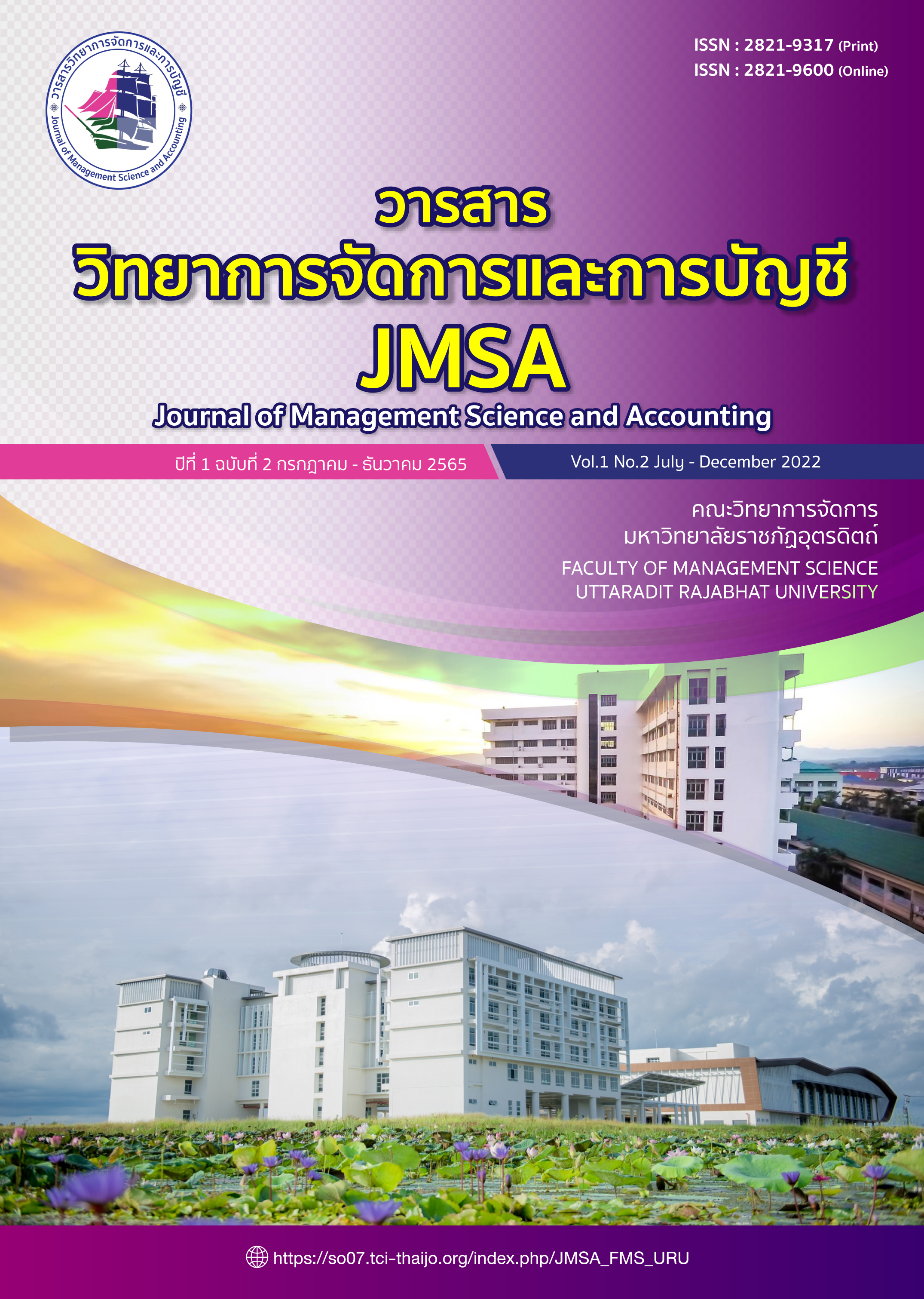การประยุกต์ใช้เทคโนโลยีอาร์เอฟไอดี (RFID) ที่มีผลต่อผลการดำเนินงานของบริษัทไปรษณีย์ไทย จำกัด
Main Article Content
บทคัดย่อ
การประยุกต์ใช้เทคโนโลยีอาร์เอฟไอดี (RFID) มาใช้ภายในบริษัทไปรษณีย์ไทย จำกัด เพื่อเพิ่มศักยภาพในการแข่งขัน การกระจายจดหมายและพัสดุ รวมไปถึงการจัดส่งจดหมายหรือพัสดุ งานวิจัยนี้มีวัตถุประสงค์เพื่อศึกษาความสัมพันธ์ในการใช้ RFID ต่อความสำเร็จของการปฏิบัติงานในบริษัทไปรษณีย์ไทย จำกัด โดยมีศูนย์บริษัทไปรษณีย์ไทย จำกัดเป็นกลุ่มตัวอย่าง และเมื่อผ่านกระบวนการ Data cleansing ทำให้ได้ข้อมูลที่ใช้ในการวิเคราะห์ทั้งหมด 152 บริษัท จากนั้นได้ทำการวิเคราะห์ด้วยรูปแบบของ การวิเคราะห์โมเดลสมการโครงสร้าง (Structural Equation Model)
ผลการวิจัยพบว่าการใช้เทคโนโลยี RFID มีผลกระทบด้านบวกกับผลการดำเนินงานในการปฏิบัติงาน นอกจากนี้การใช้เทคโนโลยี RFID ในด้านการให้ความสำคัญต่อมุมมองของธุรกิจ และ การให้ความสำคัญต่อการวางแผนกลยุทธ์ มีผลกระทบที่เป็นบวกต่อประสิทธิภาพในการดำเนินงานในด้านประสิทธิภาพในการทำงานมากขึ้น
Article Details

อนุญาตภายใต้เงื่อนไข Creative Commons Attribution-NonCommercial-NoDerivatives 4.0 International License.
บทความที่ได้รับการตีพิมพ์ในวารสารวิทยาการจัดการและการบัญชี มหาวิทยาลัยราชภัฏอุตรดิตถ์ เป็นลิขสิทธิ์ของมหาวิทยาลัยราชภัฎอุตรดิตถ์
บทความที่ลงตีพิมพ์ใน วารสารวิทยาการจัดการและการบัญชี มหาวิทยาลัยราชภัฎอุตรดิตถ์ ถือว่าเป็นความเห็นส่วนตัวของผู้เขียน คณะบรรณาธิการไม่จำเป็นต้องเห็นด้วย ผู้เขียนต้องรับผิดชอบต่อบทความของตนเอง
ผู้เขียนที่ตีพิมพ์ ยอมรับเงื่อนไขต่อไปนี้:
- ผู้เขียนรักษาลิขสิทธิ์และให้สิทธิ์วารสารในการตีพิมพ์ครั้งแรกพร้อมกับผลงานที่ได้รับใบอนุญาตพร้อมกันภายใต้ Attribution-NonCommercial-NoDerivatives 4.0 International (CC BY-NC-ND 4.0) ที่อนุญาตให้ผู้อื่นแบ่งปันผลงานโดยรับทราบถึงผลงานของผู้เขียนและ การตีพิมพ์ครั้งแรกในวารสารนี้
- ผู้เขียนสามารถทำข้อตกลงเพิ่มเติมตามสัญญาแยกต่างหากสำหรับการเผยแพร่ผลงานฉบับตีพิมพ์ของวารสารแบบไม่ผูกขาด (เช่น โพสต์ลงในพื้นที่เก็บข้อมูลของสถาบันหรือตีพิมพ์ในหนังสือ) โดยรับทราบการตีพิมพ์ครั้งแรก ในวารสารนี้
- ผู้เขียนได้รับอนุญาตและสนับสนุนให้โพสต์ผลงานของตนทางออนไลน์ (เช่น ในคลังข้อมูลของสถาบันหรือบนเว็บไซต์) ก่อนและระหว่างขั้นตอนการส่งผลงาน เนื่องจากอาจนำไปสู่การแลกเปลี่ยนที่มีประสิทธิผล ตลอดจนการอ้างอิงงานที่ตีพิมพ์เร็วขึ้นและมากขึ้น
เอกสารอ้างอิง
Asif, Z. (2005). Integrating the supply chain with RFID: A technical and business analysis. Communications of the Association for Information Systems, 15(1), 24.
Bunduchi, R., Weisshaar, C., & Smart, A. U. (2011). Mapping the benefits and costs associated with process innovation: The case of RFID adoption. Technovation, 31(9), 505-521.
Anh, P. C., & Matsui, Y. (2011). Relationship between quality management information and operational performance: International perspective. Management Research Review, 34(5), 519-540.
Chiewnawin, P. (2009). Utilization of Radio Frequency Identification (RFID) Technology for Supply Chain Management of Automotive Parts Industry in Thailand. Doctoral dissertation, Mahidol University. 22-24.
Fornell, C., & Larcker, D. F. (1981). Structural equation models with unobservable variables and measurement error: Algebra and statistics. Journal of marketing research, (18(1), 39-50.
Feng, M., Terziovski, M., & Samson, D. (2007). Relationship of ISO 9001: 2000 quality system certification with operational and business performance: A survey in Australia and NewZealand-based manufacturing and service companies. Journal of Manufacturing Technology Management, 19(1), 22-37.
Heng, S. (2006). Rfid Chips: Future Technology on Everyone's Lips. Deutsche Bank Research, E-conomics, 20(2), 3299.
Jaska, P., Reyes, P., Zelbst, P. J., Green Jr, K. W., & Sower, V. E. (2010). Impact of RFID technology utilization on operational performance. Management Research Review, 33(10), 994-1004.
Liu, G., Yu, W., & Liu, Y. (2006). Resource management with RFID technology in automatic warehouse system. [Paper presented at the 2006]. 2006 IEEE/RSJ International Conference on Intelligent Robots and Systems, 6(1), 3706-3711.
Mabin, V. J., & Balderstone, S. J. (2003). The performance of the theory of constraints methodology: analysis and discussion of successful TOC applications. International Journal of Operations & Production Management, 23(6), 1602-1635.
Nuchtiphong, U., Jaturat, N., & Kingsida, S. (2020). The Impact of RFID Utilization on Firms Performance through Decision Making of Automotive Manufacturers Industry. Progress in Applied Science and Technology, 10(1), 207-214.
Zelbst, P. J., Green, K. W., Sower, V. E., & Baker, G. (2010). RFID utilization and information sharing: the impact on supply chain performance. Journal of Business & Industrial Marketing, 25(8), 582-589.
Zelbst, P. J., Green, K. W., Sower, V. E., & Reyes, P. M. (2012). Impact of RFID on manufacturing effectiveness and efficiency. International Journal of Operations & Production Management, 32(3), 329-350.
Zhao, W., Yu, Q.-q., Li, H.-s., & Tian, Y.-z. (2014). Study on the relationship between JIT practices and operational performance based on the cost leading strategy. [Paper presented at the 2014]. International Conference on Management Science & Engineering 21th Annual Conference Proceedings. 21(1), 329-334.


